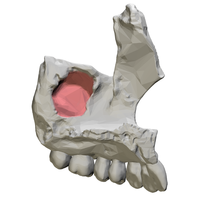
Photo from wikipedia
Purpose To evaluate the reliability of cone beam computed tomography (CBCT) imagining in the assessment of the frequency, location, and morphological characteristics of accessory maxillary ostia (AMOs), and to analyze… Click to show full abstract
Purpose To evaluate the reliability of cone beam computed tomography (CBCT) imagining in the assessment of the frequency, location, and morphological characteristics of accessory maxillary ostia (AMOs), and to analyze a potential association with sinus and dentoalveolar pathologies. Methods CBCT scans with bilateral maxillary sinuses that were acquired from September 2016 to September 2018 were initially screened. A total of 160 CBCT scans (320 sinuses) that fulfilled the inclusion criteria were included for further analysis. The presence, location, and morphological characteristics of the AMOs were evaluated in axial, coronal, and sagittal CBCT views. The findings were correlated with age, gender, sinus, and dentoalveolar pathology to assess for potential influencing factors on AMOs. Results An AMO was present in 151 (47.2%) of the 320 sinuses. Most of the AMOs were located within the region of the nasal fontanelle or hiatus semilunaris (81.1%) presenting with an ovaloid (48.4%) or a round shape (39.0%). The average length of the AMOs was 2.33 ± 1.42 mm, occupying an area of 3.43 ± 4.51 mm 2 , respectively. Morphological changes of the maxillary sinus mucosa were positively associated with length and area of AMOs. Furthermore, the status of the dentition in the posterior maxilla seemed to be an influencing factor on AMO shape. Conclusions Nearly half of the maxillary sinuses assessed in the present study population had an AMO. Pathologies of the maxillary sinus seem to have an impact on AMOs, which is demonstrated here by morphological changes of the sinus mucosa being associated with an increase in length and area of accessory ostia.
Journal Title: Surgical and Radiologic Anatomy
Year Published: 2019
Link to full text (if available)
Share on Social Media: Sign Up to like & get
recommendations!